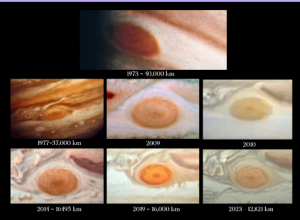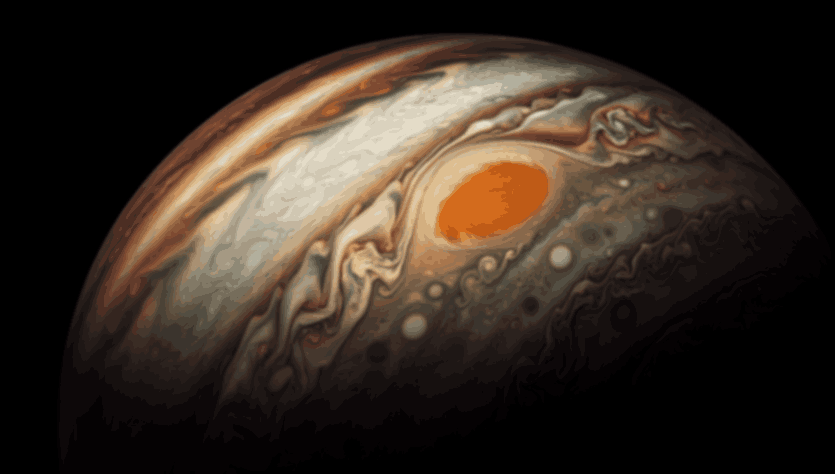Jupiter, the colossal gas giant of our solar system is distinguished by its iconic great red spot. Which has been raging over for hundreds of years. This huge storm is like a never-ending hurricane approximately the size of three earths in a row. Now here’s the amazing news, this big storm has decided to hit the space gym and get smaller. Yes! Our giant gassy neighbor is making the headlines. Prepare to dive into the scientific details of Jupiter’s shrinking show as we unravel the complex physics behind the largest storm in the solar system’s dramatic decrease in size!
Jupiter’s giant great red spot is an anticyclone with wind speeds of nearly 480 km/hr. This red spot has been picturized over many decades. Let’s have a look at the image from Pioneer 10 spacecraft from 1973. It was more like a red giant sausage more elongated than what you see now. Let’s look over some more images from the Hubble spacecraft, if you look closely, the size of Jupiter’s red spot is decreasing and there has been a drastic change in size from 1973 to 2019. The latest observation of Nov 2023 shows that the size of this giant storm is just 12,821 km !! As it becomes smaller and rounder, its height also slightly increases.
Now, the reason behind this shrinking is still not well known. But scientists have proposed several theories such as the merging of the giant red spot with several other smaller storms, then the overall size of the storm will decrease. Another conclusion is that for the GRS to stay active it requires a lot of energy. So if the GRS is losing energy, then it could start to shrink. This energy loss could be due to a variety of factors, such as changes in Jupiter’s magnetic field or changes in the composition of Jupiter’s atmosphere.

There are a few key things that could be causing the Great Red Spot to shrink:
-
-
Interactions with other storms
The Great Red Spot sometimes merges with smaller storms that approach it. When it merges with smaller storms, it gains some energy initially but can also lose energy over time as the new, combined storm system stabilizes. These interactions may be gradually eroding the Great Red Spot.
-
Changes in Jupiter’s atmosphere
The gases that make up Jupiter’s atmosphere may be changing over time. This could affect how heat and energy move around in the atmosphere and impact storm systems like the Great Red Spot. For example, if the amounts of certain gases decreased, it might reduce the energy available to sustain such a massive storm.
-
Loss of internal heat
Storms require a heat source to maintain convection and circulation. One theory is that the Great Red Spot is losing some of its internal heat energy from friction and turbulence. Over hundreds of years, these thermal losses may be accumulating.
-
Changes in Jupiter’s magnetic field
Jupiter has an incredibly powerful magnetic field that interacts with the solar wind and the planet’s atmosphere. Some researchers think changes in the magnetic field could affect interior processes and heat transfer in ways that weaken the Great Red Spot.
-
No matter the reasons behind it, the Great Red Spot shrinking significantly in recent decades has intrigued astronomers. Ongoing observation and modeling are needed to determine what will happen to this iconic storm. Will it continue to gradually diminish over time? Or will it reach some new equilibrium size and persist for centuries more?
The mystery surrounding the Great Red Spot feeds our curiosity about the complex fluid dynamics that can support such an enormous vortex under Jupiter’s extreme atmospheric conditions. What physics allows it to be so long-lived compared to storms on other planets? Why is this vortex reddish in color while other Jovian storms are white or brown? Many questions remain unanswered even centuries after the storm’s discovery.
Unlocking the secrets of the solar system’s longest-lived storm system will not only satisfy our scientific wonder about Jupiter’s atmosphere but may also provide insights into vortex behavior across planetary bodies. Fundamental physics likely has broad applications. Continued observation and modeling are key as we seek to unravel what contributes to the stability of this record-breaking anticyclone and anticipate how it may continue to evolve in Jupiter’s turbulent skies.
Stay tuned for the next chapter in the story of the Great Red Spot’s size changes, fellow cosmic explorers! With so many mysteries still surrounding this raging storm, we expect new surprises and revelations in the years ahead about our solar system’s most famous storm system.

